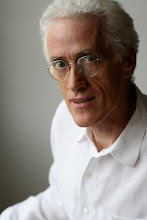In the early 80s I was at the forefront of the then mind-bending new music technologies. I had been involved a few years earlier in the build-up to the international agreement for a worldwide standard for interconnectivity between electronic musical instruments (primarily keyboards) - MIDI. The Musical Instrument Digital Interface.
Initially the language was aimed very much at keyboards being able to remotely ‘play’ other keyboards in tandem, thereby expanding the sonic combinations exponentially. Up until that time, telephone exchange-style patch-bays and routing boxes producing mountains of cable-spaghetti with converters and adaptors producing both triggers pulses that sent start and stop commands plus Control Voltages that transmitted pitch information. The language of MIDI was, nonetheless, much more of an arrangement tool, than a compositional aid.
The classic 70s image of keyboardists such as Vangelis and Rik Wakeman literally surrounded by a circle of synthesizers, organs, electric pianos et al, spreading their octopus arms in all directions, disappeared in a handful of years as MIDI cables allowed several instruments to be played at the same time in perfect unison.
It was all new and fascinating. Once all that mad control voltage and trigger-input data had been reduced to a one-size-fits-all technology, it became seductively beckoning to devise another ‘standard’ that could harness that data and invent a system that recorded it. Then it could be played back.
In that brief moment, an ideology, not a million miles away from the early exploratory days of home computing, was realised and developed into a ‘modern-day’ version of a sequencer. A recording device to capture endless information attached to chords, rhythms, melodies and sounds that together would create a new kind of control over sound and music.
As with any great new invention - a quantum jolt forward comes at a price. As a byproduct of that new and fascinating precision, the happy accidental moments, which as before, required ‘instinctive response’ (and often immediate ideas to circumnavigate potential disaster for example) became constrained to the point of suffocation.
With each new step towards the ultimate total harnessing and control of musical expression, came less and less opportunity for error and improvisation. That improvisation is what keeps the music alive and reflecting ‘feeling’.
Music composed and arranged on a computer that utilises both rhythmic quantisation and auto-tuned instrumentation is tantamount to reading music as opposed to hearing it. For those of us who can, when we read a score in our mind, without an instrument to hand, we may hum along but it is our imagination that is doing the hearing and the conducting. It is much like visualising the story whilst reading a book. With computer-controlled recording, we are getting the precise placement notes and interval/harmonic relationships but with no conducting, no overall homogeneity, no feeling.
Let’s not forget that the only commonality between almost all great quotes on music over several centuries lies in that word - ‘feeling.’ That’s what music does…. creates feelings for others to encounter. The artist conjures up feelings for their audience to experience. That’s it.

